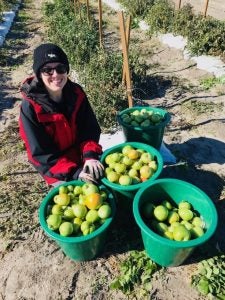A nematology professor and doctoral candidate at the University of Florida are tackling a plant destroyer
Superheroes are often viewed as good, while villains are considered to be bad — there is a clear and pronounced separation between the likes of Batman and the Joker or the X-Men and the Brotherhood of Mutants. But what if those kinds of allegiances weren’t so well defined? What if their motivations and purpose landed in a grayer area, where the impact of a group’s actions could sometimes be for the better, while other times make things worse? We see that happen all the time on a microscopic level, and researchers at the University of Florida are hoping to understand how the tiny and abundant roundworms known as nematodes can sometimes play the role of superhero and other times appear to be the villain.
Nematodes live almost anywhere, such as in soil, marine environments, and even beer malts, and are the most populous animal on Earth. Four out of five animals are nematodes, according to the University of California, Davis, and it’s likely that there are many nematodes that haven’t even been discovered yet. The villain nematodes are parasitic to humans, animals, and even plants, while the superhero nematodes can help get rid of bacteria, fungi, and other pests in the soil. Understanding how these worms impact our environment have captured the attention of two University of Florida scientists.

Nematology faculty member Billy Crow and doctoral candidate Lesley Schumacher study microscopic worms that live in the soil. You might say the nematodes they research fall into the villain category. These villains are known as plant-parasitic nematodes, and they harm all types of plants, from tomatoes to turfgrass. These nematodes feed on a plant’s root system, which reduces the ability for plants to take in water and nutrients. There are also foliar nematodes, which damage plant parts like leaves and buds, causing problems for new growth .
“Worldwide, the most common method of managing plant-parasitic nematodes is crop rotation; planting a non-host crop after a susceptible one to keep nematode numbers from getting high,” Crow says. “The next most common tactic is use of resistant cultivars, breeding plants that do not suffer as much nematode damage. For high-value crops, chemical nematicides are often used to hold nematodes in check.”
Nematicides are used to kill plant-parasitic nematodes. Nematicides can either be fumigants and nonfumigants. Fumigant is when the chemicals move from the soil to gas, while nonfumigants are formulated in liquid and are moved through the soil to water, according to University of Florida Extension.
Working with microscopic worms isn’t an easy task. “Nematodes are very small, so you must have the proper method to extract them from soil or plant material. This can be time-consuming and tedious process, but the results are worth it,” Schumacher said.
But while the nematodes Crow and Schumacher study are usually “villains,” “most nematodes are beneficial due to their ecological role in the food web, and carbon and nitrogen cycling,” Crow said.
Schumacher is a former farmer from the Upper Midwest. Her grandfather managed a 365-acre apple orchard in Baraboo, Wisconsin. After Schumacher moved to Michigan, she got involved in 4-H, the horse industry, and became a dairy farmer. She also operated her own maple syrup business.
Schumacher became interested in nematodes when she was an undergraduate at Michigan State University. While she was a chemical engineering major, she took a biological science elective “Pests, Society, and the Environment,” taught by George Bird, Ph.D. Bird amplified her passion in nematology; she got her to work in his nematology lab and switched her major to entomology. She stayed in his lab to complete her master’s degree, where she worked on types of nematodes that are major pests to soybeans.
Currently, Schumacher works on sod-based rotation for Rotylenchulus reniformis (reniform nematode) management in peanut and cotton systems. Sod-based rotation is when you rotate a crop like peanuts and cotton with perennial grass.
Reniform nematode is a plant-damaging parasitic nematode that is known to be in tropical regions in the world. Depending on the reniform nematode population, the crop losses could range from 20 to 50 percent . Just for cotton, reniform nematode causes $130 million losses, according to the U.S. Department of Agriculture.
Her work includes exploring how management options can affect non-target nematodes.
“My research aims to help farmers battle against harmful plant-parasitic nematodes with minimal costs to the environment,” Schumacher said. “By measuring free-living nematodes, we can assess our management methods and try to find a balance between chemical and cultural management options.”
Schumacher loves what she does because she gets to help farmers find economical ways to increase crop yield.


